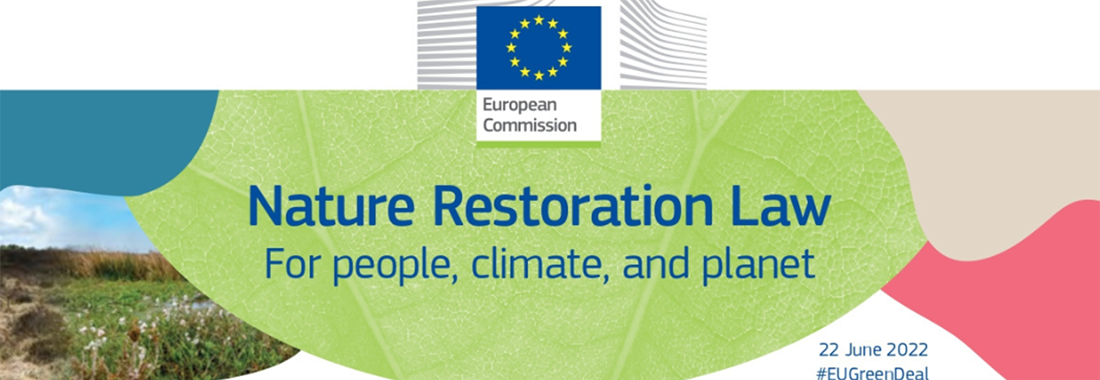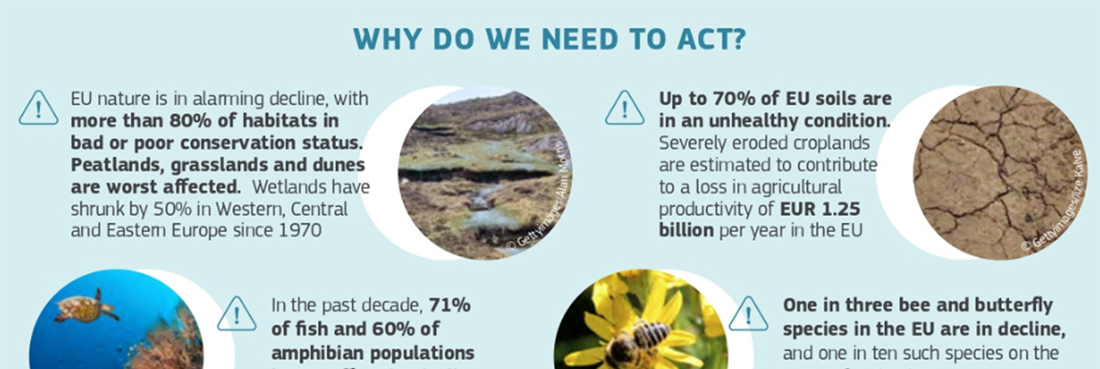With 336 votes in favour, 300 against, and 13 abstentions, the European Parliament approved on July 12th the Nature Restoration Law, a historic legislation aiming to restore 20% of natural ecosystems by 2030. The long-term objective of the Nature Restoration Law is to restore degraded natural systems by 2050, with an immediate target of restoring at least 20% of ecosystems by 2030. This ambitious commitment requires concrete efforts from member countries.
The law focuses on various intervention areas, including the enhancement of terrestrial and marine ecosystems of particular interest, restoration of urban ecosystems, and natural river connectivity. Additionally, it aims to improve agricultural ecosystems by promoting increased carbon stocks in soils and the conservation of species such as butterflies and birds.
Specifically, the Nature Restoration Law includes:
Restoration and improvement of the conservation status of terrestrial and marine ecosystems of particular interest, with progressive milestones. The goal is to restore 20% of these ecosystems by 2030 and achieve 100% by 2050.
Restoration of urban ecosystems. The aim is to avoid net losses of urban green spaces and urban tree cover by 2030 compared to 2021, with a 5% increase by 2050. Additionally, a tree cover of 10% is targeted for all urban centers by 2050.
Restoration of natural river connectivity. Member States must identify river connectivity barriers by 2030 and remove them, contributing to the EU's objective of restoring at least 25,000 km of free-flowing rivers by 2030.
Improvement of agricultural ecosystems. The focus is on increasing carbon stocks in soils, conserving butterflies and birds typical of agroecosystems, and extending agricultural areas with landscape elements of high diversity.
Development of a Restoration Plan with a time horizon until 2050. This plan will outline the quantification of areas to be restored, necessary measures to achieve objectives, and an implementation schedule.
The Nature Restoration Law represents a significant step forward for the conservation and restoration of the natural environment. Now, the European Parliament will enter negotiations with the Council to define the final form of the legislation, during which further changes to the text may be made.
The approval of this law sends a positive signal for biodiversity conservation and reflects the commitment of the European Union to preserve our ecosystems for future generations.
Regarding the restoration objectives in Sardinia, where the current surface area of protected and safeguarded areas amounts to 19% of the territory, the Regional Sustainable Development Strategy has already set a more ambitious target of aiming for 30% of restored areas by 2030, including the restoration of currently degraded areas and habitats.
Latest news

TransformAr Open Day in Marceddì: Marshes and Lagoons to Reimagine the Future
Natural Solutions to Adapt to Climate Change: Lagoons and Marshes. This topic was discussed during an immersive walk between the Marceddì Lagoon and the San Giovanni Marsh on Friday, July…

MEDSEA joined the Natural Heritage Interreg Euro-MED Mission in Rovinj for aligning in projects' Communication
MEDSEA stopped in Rovinj, Croatia, from June 26th to 27th, 2024, to participate in the Communication, Amplification and Policy activities of the Interreg Euro-MED Natural Heritage mission, which brings together the thematic projects…

DesirMED: Nature-Based Solutions for Climate Adaptation, Regional Comparison at the Mid-Year Assembl
The DesirMED project recently held its General Assembly online on June 19 and 20 to review the progress of activities in the first semester. This meeting saw the participation of all scientific partners and…

Waste Hunt at Sella del Diavolo to Protect our Cetaceans Friends
Last Saturday on June 15th, nearly a ton of waste was recovered both on land and at sea during the "Puliamo la Sella!" event in Cagliari. The collected items included…

Active Restoration of Posidonia oceanica: MEDSEA at the 2024 World Seagrass Conference in Naples
MEDSEA continues to lead in the active restoration of Posidonia oceanica, a crucial topic for the conservation of Mediterranean marine ecosystems. Recently, the guide "Guidelines for the Active Restoration of Posidonia oceanica"

TransformAr Open Day on July 5th 2024: Discovering Transformative Solutions for Climate Change at the Marceddì Lagoon
On July 5th, TransformAr presents itself to the public with a special Open Day. The European Horizon 2020 project, aimed at developing transformative solutions for climate change adaptation, invites curious minds and citizens…

Puliamo la Sella! 2024 dedicated to our cetacean friends, with WWF, returns to Cagliari on June 15, 2024
The coastal cleanup organized by the MEDSEA Foundation, Puliamo la Sella!, returns to Cagliari on June 15th 2024. This year's event, now in its sixth edition, will be a special…

Deep Dive: The Talk for World Oceans Day
World Oceans Day provided an opportunity to reaffirm the importance of acting now to protect one of our most precious assets: the marine and coastal ecosystem. The Coalitions of the…
First SEG Meeting of the BLUE4ALL Project: A Focus on Surveillance and Biodiversity Protection
On May 23, 2024, the inaugural SEG (Stakeholder Engagement Group) meeting for the BLUE4ALL Project was held at Casa Todde in Villasimius, with options for remote participation.

RICREA introduces itself in Lucca, working on updating the Contracts, and will also focus on the Blue Crab
River, lagoon, and water body contracts in general are an exceptional tool for sustainable and participative environmental management, essential for the protection of water resources and local biodiversity. However, there…

TransformAr: Climate Adaptation Pathways Finalized for the Fisheries and Agriculture Sector in Terralba
This week, a participatory workshop was held in Terralba as part of the TransformAr project to finalise the adaptation pathways developed with local operators, particularly in the fisheries, agriculture, and biodiversity sectors.

ARTEMIS, Partner Meeting in Marseille to Kick Off Activities
On May 15th and 16th, at the Plan Bleu headquarters in Marseille, the first in-person meeting of the ARTEMIS project was held since the kickoff in March. ARTEMIS is a project within the…

DEEP DIVE: The Alarming State of the Ocean – Inspiring Action and Searching for Solutions (Webinar)
In celebration of World Ocean Day, MEDSEA invites you to the online event "Deep Dive: The Alarming State of the Ocean", a detailed analysis of the challenges that oceans are…

Fire Monitoring Test successfully conducted in Santu Lussurgiu thanks to IoT Technologies
At the end of April, a major breakthrough in fire prevention technology was achieved in the forests of San Leonardo. Thanks to pre-fire detection sensors, an IoT (Internet of Things) technology developed and…

REST COAST, at the annual meeting in Groningen, demonstrates the effectiveness of natural restoration of aquatic systems
The standstill of the Nature Restoration Law, the European law on nature restoration, stalled in its final approval phase in the Council due to the hesitations of some Member States, has…

TransformAr makes a stop in Finland for the sixth Consortium Meeting
In mid-April, the sixth Consortium meeting of the H2020 TransformAr Project was held in Lappeenranta, recognized as the Climate Capital of Finland. This city truly exemplifies sustainability, with 100% of waste recycled and all…
- 1
- 2
- 3
- 4


